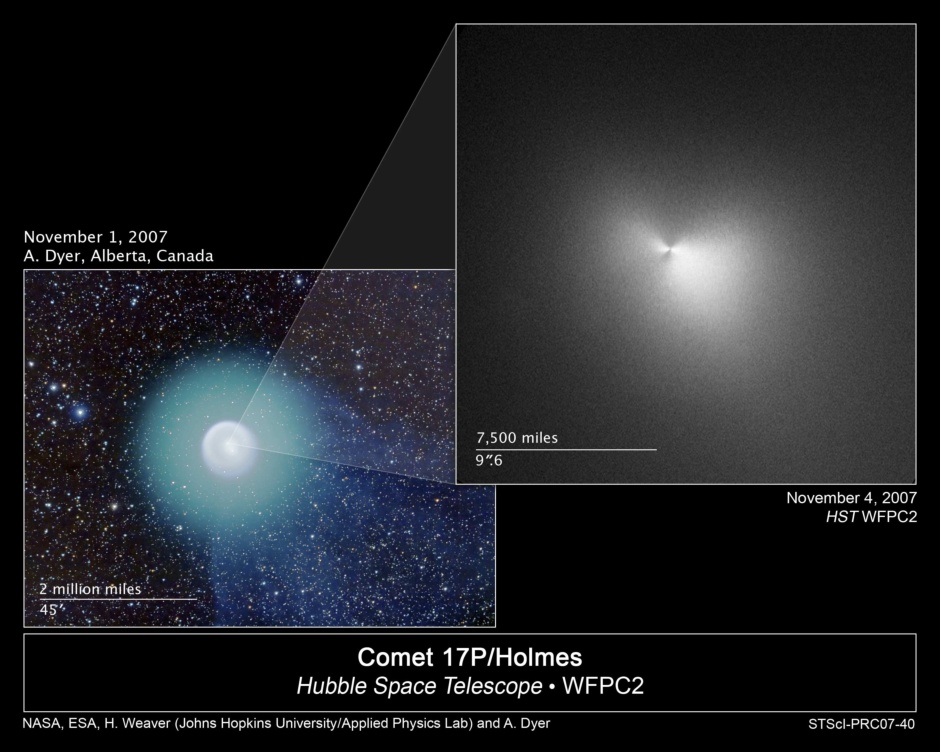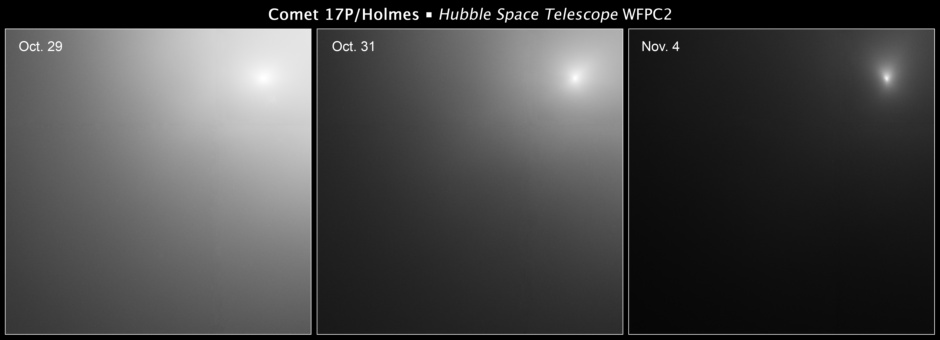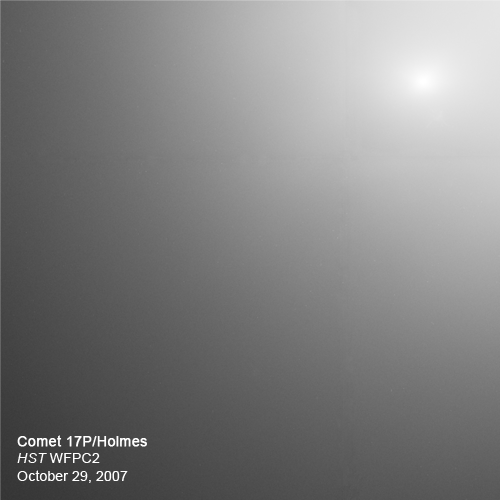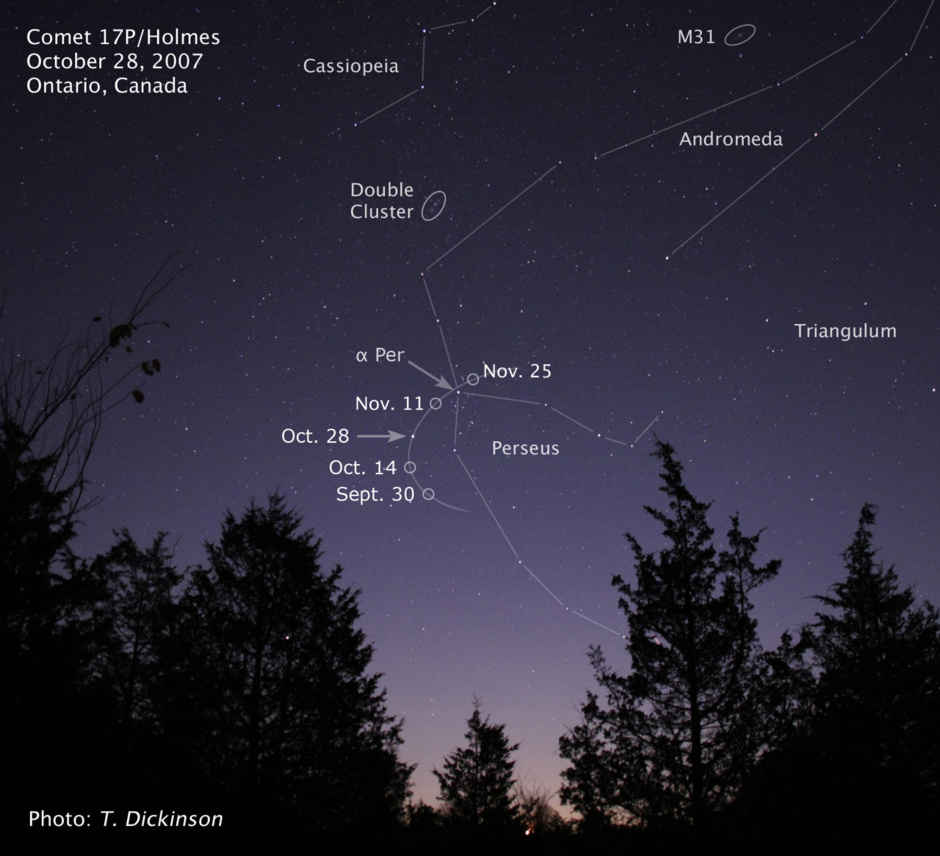<오른쪽은 허블 망원경이 촬영한 이미지이고, 왼쪽은 천체사진촬영가 앨런 다이어(Alan Dyer)에 의해
2007년 1월 캐나다 southern Alberta에서 촬영되었다.>
허블우주망원경이 Comet 17P/Holmes(일명 홈즈혜성)의 핵을 세밀하게 탐사했다.
천문학자들은 허블의 고해상도 기능을 활용하여 어떻게 이 혜성이 이토록 밝은 빛을 내는지를 추적했다.
허블 우주 망원경은 WFPC2(Wide Field Planetary Camera 2)를 이용하여 10월 29일, 31일, 11월 4일에 걸쳐 이 헤성을 촬영했다.
허블의 '또릿또릿한 눈'은 54킬로미터 정도의 작은 거리를 식별해 낼 수 있으며, 이를 통해 눈부신 빛을 발산하는 원천을
선명하게 잡아낼 수 있었다.
오른쪽에 있는 사진은 11월 4일에 촬영된 것으로 홈즈 혜성의 심장에 해당한다.
이 사진의 중심부는 핵 부근의 먼지들 속에서 가장 밝은 부분을 특별히 강조 처리한 것이다.
동서 축으로 존재하는 먼지는 남북 축으로 있는 먼지보다 2배 이상 많이 존재하며 이로 인해서 혜성이 나비 넥타이 형태의 외양을
나타내고 있는 것이다.
왼쪽의 색채합성 이미지는 11월 1일에 아마추어 천문학자에 의해 찍힌 사진으로,
혜성의 오른쪽 방향으로 흩뿌려지고 있는 희미한 꼬리와 , 먼지가 집중되어 있는 반복적인 동심원 모양의 중앙부를 포함하여
혜성의 전반적인 복잡한 구조를 보여주고 있다.
혜성의 모든 활동의 궁극적 원천이 되는 작고 단단한 물체인 핵은 폭발이 있은지 12일이 지난 후에도 여전히 밝은 먼지들에 뒤덮혀 있다.
허블 탐사를 지휘하고 있는 존스홉킨스 대학 응용물리학 연구소의 할 위버(Hal Weaver)는 밝은 빛에 대해 다음과 같이 설명했다.
"허블을 통해 관측한 대부분의 이미지는 태양빛이 혜성으로부터 품어져 나온 미세한 원자들에 의해 산란되고 있는 모습입니다.
그러나 우리는 최종적으로 허블을 통해 이 혜성의 핵 스스가 응급상황에 처하는 모습을 관측하기 시작하게 될 것입니다."
(핵이 마침내는 붕괴할 것이라는 뜻임. : 옮긴이)
허블이 처음으로 홈즈혜성을 관측했던 1999년 6월 15일에는 사실상 핵주위를 감싸고 있는 먼지들은 일체 존재하지 않았었다.
오늘날 비록 허블을 통하여서도 핵의 모습을 명확하게 관측할 수는 없지만 밝기 측정을 통해 크기를 유추해 볼 수는 있다.
천문학자들은 홈즈혜성의 핵의 지름이 대략 3.4 킬로미터로서, 뉴욕 센트럴 파크의 길이 정도에 해당한다고 추측했다.
천문학자들은 또한 허블 망원경을 이용하여 폭발이 발생하는 동안 얼마나 많은 먼지들이 분출되었는지를 관찰함으로써 이 혜성의 크기를
결정할 수 있기를 희망하고 있다.
허블이 일전에 촬영한 두 장의 홈즈 혜성 사진 역시 흥미로운 구조들을 보여주고 있다.
10월 29일 허블은 핵으로부터 분출되고 있는 세 개의 '돌기'를 볼 수 있었고 다른 한편으로는 10월 31일에 먼지분출이
핵의 서쪽구역에서만 발생된다는 것을 알 수 있었다.
그러나 홈즈 혜성에서는 슈바스만-바크만 3 혜성(SW3)때와는 달리 핵 부근에서 일체의 덩치큰 파편들이 발견되지는 않았다.
2006년 봄, 허블은 SW3 혜성이 극적으로 그 밝기가 증가된 후, 파편으로 분리되어 떨어져나온 일단의 '작은 혜성'들을 발견할 수 있었다.
지상에서 촬영된 홈즈 혜성의 사진(왼쪽 사진)을 보면, 핵으로부터 파생되어 나와 구형대칭을 이룬
동심원 모양의 먼지구름을 볼 수 있는데 이를 통해 커다란 조각들이 핵으로부터 떨어져 나온 후,
계속적으로 작은 먼지로 분쇄되어가는 과정이 진행되고 있음을 알 수 있다..
그러나 불행하게도 이러한 조각들은 그 크기가 핵 정도의 크기에 상응하지 않는다면, 현재로서는 관측할 수가 없는 상황이다.
이유인즉, 핵 주위를 둘러싸고 있는 엄청난 양의 먼지 때문이기도 하고,
지구로부터 혜성까지의 거리가 상대적으로 멀기 때문이기도 하다.
(SW3 혜성의 경우는 1440만 킬로미터(0.1AU)의 거리였으나 홈즈혜성은 2억 3840만 킬로미터(1.6AU)나 떨어져 있다.)
이 일련의 사진들은 허블에 의하여 촬영된 홈즈 혜성의 중심부이다.
시간 순으로 보면 먼지와 가스 구름에 둘러싸여 점점 밝기가 희미해 지고 있음을 알 수 있다.
이 혜성이 가장 밝았었던 때는 10월 29일이었는데, 10월 31일에는 두 배, 그리고 11월 4일에는 9배로 밝기가 줄어들었다.
< 이 이미지를 보면 밝기의 변화를 비교할 수 있다.>
혜성의 밝기가 계속 줄어드는 것은 팽창과 관련이 있다.
10월 23일에 있었던 폭발을 통해 대량의 작은 먼지들이 생겨났는데 이후에 이 먼지들은 핵으로부터 떨어져 나와 우주 공간으로 흩어졌다.
이러한 와중에 혜성의 밝기가 점점 줄어들고 있는 것이다.
그러나 홈즈 혜성의 핵은 여전히 활동적이고 많은 양의 새로운 먼지들을 계속 쏟아내고 있다.
그래서 혜성의 핵 주변에서는 관측 당시보다 여전히(최소한 10배 이상)의 밝기가 유지되고 있는 것이다.
홈즈 혜성 관측팀의 구성원은 다음과 같다.
H. Weaver와 C. Lisse(존스홉킨스 대학 응용 물리학 연구소)
P. Lamy(프랑스 마르세이유 천체물리학 연구소)
I. Toth(헝가리 콘콜리 연구소)
M.Mutchler(우주망원경 연구소)
W. Reach(캘리포니아 기술 연구소)
<지상에서 관측한 홈즈혜성의 위치>
* '허블사이트'의 게시물들은 허블사이트 http://hubblesite.org 의 뉴스센터 자료들을 번역한 자료들입니다
For additional information, contact
Donna Weaver/Ray Villard
Space Telescope Science Institute, Baltimore, Md.
410-338-4493/4514
dweaver@stsci.edu/villard@stsci.edu
Mike Buckley
The Johns Hopkins University Applied Physics Laboratory, Laurel, Md.
240-228-7536
mike.buckley@jhuapl.edu
Lars Lindberg Christensen
Hubble/ESA, Garching, Germany
011-49-89-3200-6306
lars@eso.org
Dr. Hal Weaver
The Johns Hopkins University Applied Physics Laboratory, Laurel, Md.
443-778-8078
hal.weaver@jhuapl.edu
원문>
ABOUT THIS IMAGE:
NASA's Hubble Space Telescope has probed the bright core of Comet 17P/Holmes, which, to the delight of sky watchers, mysteriously brightened by nearly a millionfold in a 24-hour period beginning Oct. 23, 2007.
Astronomers used Hubble's powerful resolution to study Comet Holmes' core for clues about how the comet brightened. The orbiting observatory's Wide Field Planetary Camera 2 (WFPC2) monitored the comet for several days, snapping images on Oct. 29, Oct. 31, and Nov. 4. Hubble's crisp "eye" can see objects as small as 33 miles (54 kilometers) across, providing the sharpest view yet of the source of the spectacular brightening.
The Hubble image at right, taken Nov. 4, shows the heart of the comet. The central portion of the image has been specially processed to highlight variations in the dust distribution near the nucleus. About twice as much dust lies along the east-west direction (the horizontal direction) as along the north-south direction (the vertical direction), giving the comet a "bow tie" appearance.
The composite color image at left, taken Nov. 1 by an amateur astronomer, shows the complex structure of the entire coma, consisting of concentric shells of dust and a faint tail emanating from the comet's right side.
The nucleus-the small solid body that is the ultimate source of all the comet's activity- is still swaddled in bright dust, even 12 days after the spectacular outburst. "Most of what Hubble sees is sunlight scattered from microscopic particles," explained Hal Weaver of The Johns Hopkins University Applied Physics Laboratory in Laurel, Md., who led the Hubble investigation. "But we may finally be starting to detect the emergence of the nucleus itself in this final Hubble image."
Hubble first observed Comet 17P/Holmes on June 15, 1999, when there was virtually no dusty shroud around the nucleus. Although Hubble cannot resolve the nucleus, astronomers inferred its size by measuring its brightness. Astronomers deduced that the nucleus' diameter was approximately 2.1 miles (3.4 kilometers), about the length of New York City's Central Park. They hope to use the new Hubble images to determine the size of the comet's nucleus to see how much of it was blasted away during the outburst.
Hubble's two earlier snapshots of Comet Holmes also showed some interesting features. on Oct. 29, the telescope spied three "spurs" of dust emanating from the nucleus, while the Hubble images taken on Oct. 31 revealed an outburst of dust just west of the nucleus.
The Hubble images, however, do not show any large fragments near the nucleus of Comet Holmes, unlike the case of Comet 73P/Schwassmann-Wachmann 3 (SW3). In the spring of 2006 Hubble observations revealed a multitude of "mini-comets" ejected by SW3 after the comet increased dramatically in brightness.
Ground-based images of Comet Holmes show a large, spherically symmetrical cloud of dust that is offset from the nucleus, suggesting that a large fragment broke off and subsequently disintegrated into tiny dust particles after moving away from the main nucleus.
Unfortunately, the huge amount of dust near the comet's nucleus and the comet's relatively large distance from Earth (149 million miles, or 1.6 astronomical units, for Holmes versus 9 million, or 0.1 astronomical unit for SW3), make detecting fragments near Holmes nearly impossible right now, unless the fragments are nearly as large as the nucleus itself.
The Hubble Comet Holmes observing team comprises H. Weaver and C. Lisse (The Johns Hopkins University Applied Physics Laboratory); P. Lamy (Laboratoire d'Astrophysique de Marseille, France); I. Toth (Konkoly Observatory, Hungary); M. Mutchler (Space Telescope Science Institute); W. Reach (California Institute of Technology); and J. Vaubaillon (California Institute of Technology).
'3. 천문뉴스 > 허블사이트' 카테고리의 다른 글
| 허블망원경을 통해 이룩한 과학적 발견 -5- (0) | 2007.11.18 |
|---|---|
| 허블망원경을 통해 이룩한 과학적 발견 -4- (0) | 2007.11.17 |
| 허블망원경을 통해 이룩한 과학적 발견 -3- (0) | 2007.11.15 |
| 허블망원경을 통해 이룩한 과학적 발견 -2- (0) | 2007.11.14 |
| 허블망원경을 통해 이룩한 과학적 발견-1- (0) | 2007.11.13 |



